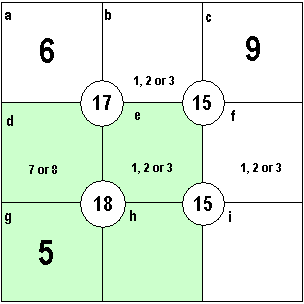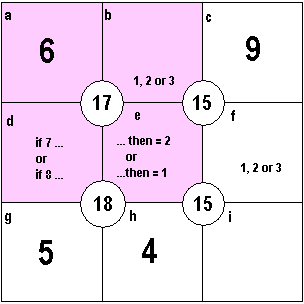summary:- tutorial to solve sujiko puzzles by the use of logic
|
||||||||||||
|
see
also solving sudoku puzzles and futoshiki
puzzles
|
||||||||||||
|
These puzzles have just started in the Daily Telegraph and are another example of using pure logic to find the solution. You do not need to be good at maths. As with all puzzles, a computer program can be written to solve it but where is the fun or skill in that? Only in writing the program - not in using it. My first tutorial uses Sujiko puzzle #4 that appeared in the Daily Telegraph on March 29th. 2011 and rated with a 'moderate' level of difficulty. The rules of Sujiko are simple. There is a 3x3 grid for the numbers 1 to 9; the position of some of them is given. Numbers can not be repeated and all the numbers 1 to 9 must be used. In the grid are four circles containing a number. The number in each circle is the sum of the numbers in the four squares surrounding it. My method is to take each block of four squares and list the possible numbers in each square and then use logic to get the result. As is often the case in tutorials, it takes a lot longer to explain here than to actually do it. Here are some tips to help you work out a sujiko grid.
|
||||||||||||
|
copyright 2012 roger walker




